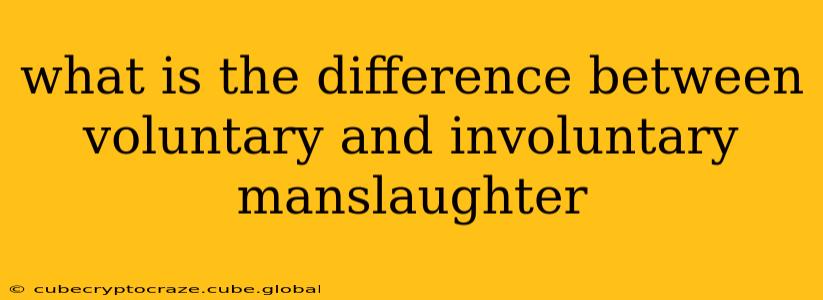Voluntary and Involuntary Manslaughter: Understanding the Key Differences
Manslaughter, a less severe charge than murder, involves the unlawful killing of another human being without malice aforethought. However, even within manslaughter, there's a crucial distinction between voluntary and involuntary manslaughter, based on the presence or absence of intent. This distinction significantly impacts sentencing and legal consequences. Let's delve into the key differences.
What is Voluntary Manslaughter?
Voluntary manslaughter occurs when the killing is unlawful but committed in the heat of passion, sudden quarrel, or under extreme provocation. It's characterized by the presence of intent to kill or cause grievous bodily harm, but this intent is mitigated by circumstances that reduce the culpability from murder to manslaughter. Essentially, the defendant acted impulsively in response to a triggering event.
Key Elements of Voluntary Manslaughter:
- Intent: There must be an intent to kill or cause serious bodily harm. This distinguishes it from involuntary manslaughter where intent is absent.
- Provocation: A significant provocation or triggering event must have immediately preceded the killing. This provocation must be sufficient to cause a reasonable person to lose self-control. The exact definition of "sufficient provocation" varies depending on jurisdiction and the specific facts of the case.
- Heat of Passion: The killing must have occurred while the defendant was in a state of intense emotional arousal, caused by the provocation. There's usually a very short time lapse between the provocation and the killing.
- Absence of Malice Aforethought: Although intent is present, the premeditation and planning associated with malice aforethought are absent.
Example: A husband discovers his wife in bed with another man. In a fit of rage, he immediately attacks and kills the other man. This could be considered voluntary manslaughter, depending on the specific circumstances and the court's interpretation of the provocation and heat of passion.
What is Involuntary Manslaughter?
Involuntary manslaughter, on the other hand, is an unintentional killing resulting from criminal negligence or recklessness. It lacks the element of intent to kill or cause serious harm that's present in voluntary manslaughter. The defendant's actions, though unlawful, were not deliberately intended to cause death.
Key Elements of Involuntary Manslaughter:
- Absence of Intent: This is the defining feature. The defendant didn't intend to cause death or serious harm.
- Criminal Negligence: The defendant acted in a grossly negligent manner, showing a substantial lack of care for the safety of others. This negligence must be so extreme that it goes beyond simple carelessness and rises to the level of criminal culpability.
- Unlawful Act Manslaughter: This is a specific type of involuntary manslaughter where death results from an unlawful act, even if the defendant didn't intend to harm anyone. For example, someone committing a robbery who accidentally causes a death during the crime.
Example: A driver, driving under the influence of alcohol, runs a red light and causes a fatal accident. The driver did not intend to kill anyone, but their reckless actions caused a death, constituting involuntary manslaughter.
What are the differences in sentencing?
Sentencing for manslaughter varies widely depending on jurisdiction, the specifics of the crime, and the defendant's criminal history. However, generally, voluntary manslaughter carries a harsher sentence than involuntary manslaughter because of the presence of intent, even if mitigated by circumstances. Voluntary manslaughter may result in lengthy prison sentences, while involuntary manslaughter may lead to lesser sentences, including probation or shorter prison terms.
What is the difference between manslaughter and murder?
Both manslaughter and murder involve the unlawful killing of another human being, but the key difference lies in the presence or absence of malice aforethought. Murder requires malice aforethought—premeditation, planning, or intent to kill or cause serious bodily harm. Manslaughter lacks this element of premeditation. Manslaughter is generally viewed as a less severe crime than murder, hence the lower penalties.
This information is for educational purposes only and should not be considered legal advice. The specifics of manslaughter charges and sentencing can vary significantly by jurisdiction and the specific facts of each case. Consult with a legal professional for guidance on any legal matter.
